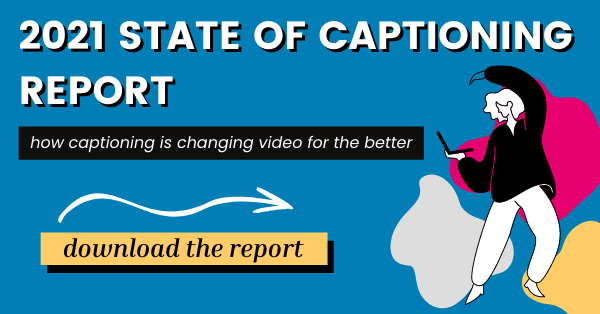3 Ways Video Has Changed for the Better
Updated: April 7, 2021
Decades ago, video’s uses were mostly limited to entertaining, informing, and advertising.
Today, video has all but replaced classrooms, text books, work travel, and meeting rooms.
2020 brought upon countless changes to the world – and one of the reasons people maintained some sense of normalcy throughout it was video. FaceTime made it possible to see our families on Christmas, Zoom allowed us to collaborate with our peers online, and HBO Max kept us entertained when we couldn’t leave our homes on a Friday night.
And while video’s place in society has changed in the past twelve months, video itself has changed, too. Videos and the content within them have become more original and more accessible. Its uses have both become broader and more niche.
Specifically, we’ve seen video change for the better in each of these key ways.
Read 3Play’s 2021 State of Captioning Report!
1. More Videos Are Being Captioned
In 3Play Media’s 2021 State of Captioning Report, it was clear how important captioning videos is to companies – specifically, how increasingly important captioning is becoming.
For example, 87% of respondents reported captioning all, most, or at least some of their video content – an increase from 84% in 2020. Additionally, 43% of respondents said they caption all videos on social media – an increase of eight percentage points from the 2020 report.
Finally, 50% indicated that they have a clear policy for captioning compliance (also an eight percentage point increase), and 51% have clear captioning processes and procedures (up from 37% in2020).
The shift in these numbers makes it clear that – due to the many benefits of captions – the world is gravitating towards a new normal where captions are not an afterthought.
According to the report, the main drivers for captioning videos are:
- Accessibility reasons. 56% of businesses cite accessibility as the top reason to caption videos, with 50% saying the same as their top reason to caption social media videos.
- Legal compliance. 15% of respondents named legal compliance a key reason for captioning, likely to avoid accessibility lawsuits. This popularity of this reason actually dropped from 25% ofrespondents in the 2020 survey, suggesting a potential move towards a proactive, accessibility-first process and rationale for captioning video content.
- Booting engagement. In a world where Facebook video ads with captions increase view time by 12%, it’s no surprise that 19% of businesses cite engagement as a key reason to caption social media videos.
- Increasing viewership. Captioned YouTube videos see 7% more views than their non-captioned counterparts, explaining why 10% of businesses named viewership as a reason for captioning.
- Better learning outcomes. 8% of respondents selected better learning outcomes as their reason for captioning video, which makes sense given the influx of video (and increased need forcaptioning) in the classroom in the last year.
For more insights on captioning, download 3Play’s 2021 State of Captioning Report ➡️
2. Live Video is Back
It wasn’t long ago when Facebook Live was seen as a momentary fad that had seen its time in the sun come to an end.
Now, the ability to “go live” is not a fad, but rather a valuable business tool. As much of the workforce continues to operate remotely, one thing is for certain – people are even more attached to their laptops than they normally would be, meaning live video remains an enticing and effective option for both companies and consumers.
Specifically, companies are using live video as a tactic for:
- Hosting live events in lieu of in-person travel, conferences, and meet-ups.
- Running webinars to boost brand awareness, generate leads, and connect with their customer base.
- Increasing social media engagement by going live on Instagram and Facebook on topical trends.
The immediacy of live video – in conjunction with its ability to bring a physically disparate audience together – is keeping live streaming alive in the 2020s. This is why 49% of respondents in the 2021 State of Captioning Report survey indicated that they stream anywhere from 25 to 1,000 hours of live video content annually.
These trends are also mirrored in live video captioning. Three out of five of businesses that engage in live video streaming reported that they caption that content, with 48% stating that they use a live automatic captioning tool to do the job (which – while certainly helpful – should be edited for the accuracy of the recorded video’s caption files).
The fact that a majority of live-streaming businesses are captioning their live content is yet another example of video changing for the better, as it makes live video more accessible and engaging.
Learn more about how and why businesses are captioning videos ➡️
3. Businesses and Marketers (Are Continuing to) See Video’s Value
According to Wyzowl’s State of Video Marketing Survey, 87% of video marketers reported a positive ROI from video, 78% claim video directly helped to increase sales, and 93% believe video is an important part of their marketing strategy – proving businesses saw a ton of value in video in the last year.
For context, the same report in 2015 found only 33% of marketers saw a positive return on investment from video, suggesting that companies are building (and benefitting from) stronger video programs and seeing the impact video can have on their bottom lines.
Naturally, the pandemic has also changed the way companies are approaching video. 91% of marketers believe it has made video more important for brands, and approximately three out of ten marketers claim they would be more likely to use video as a result. This increase in interest follows suit with the report’s finding that approximately 65% of consumers saying they’ve increased the amount of video they’ve watched online.
These figures make it evident that those who market – and those to whom they market – see no shortage of video in the future. Thankfully, marketing leaders agree and plan to invest in the continued growth of video. According to Wyzowl, approximately 60% of video marketers expected their budgets will change in 2021, with 70% of that cohort expecting a budget increase.
When it comes to captioning, businesses are seeing reasons to invest there as well. 3Play’s State of Captioning Report found that 49% of respondents stated their captioning budgets saw an increase in 2021, while only 28% of 2020 respondents said the same. This increase of nearly 20 percentage points reportedly was due to multiple factors, including boosting the brand’s profile and an audience demand for captioning.
An Increasingly Positive Future for Video
From the way it is created to the way it is consumed, video continues to change for the better. Companies are seeing strong returns on their investments, which is leading to increased video budgets and more ways to interact with (and grow) an audience.
From a captioning and accessibility standpoint, video has seen a drastic improvement in just the last twelve months, helping businesses get found easier, retain viewers, and be more accessible.
You can read more about how captioning is helping to change video for the better in 3Play Media’s 2021 State of Captioning Report.











